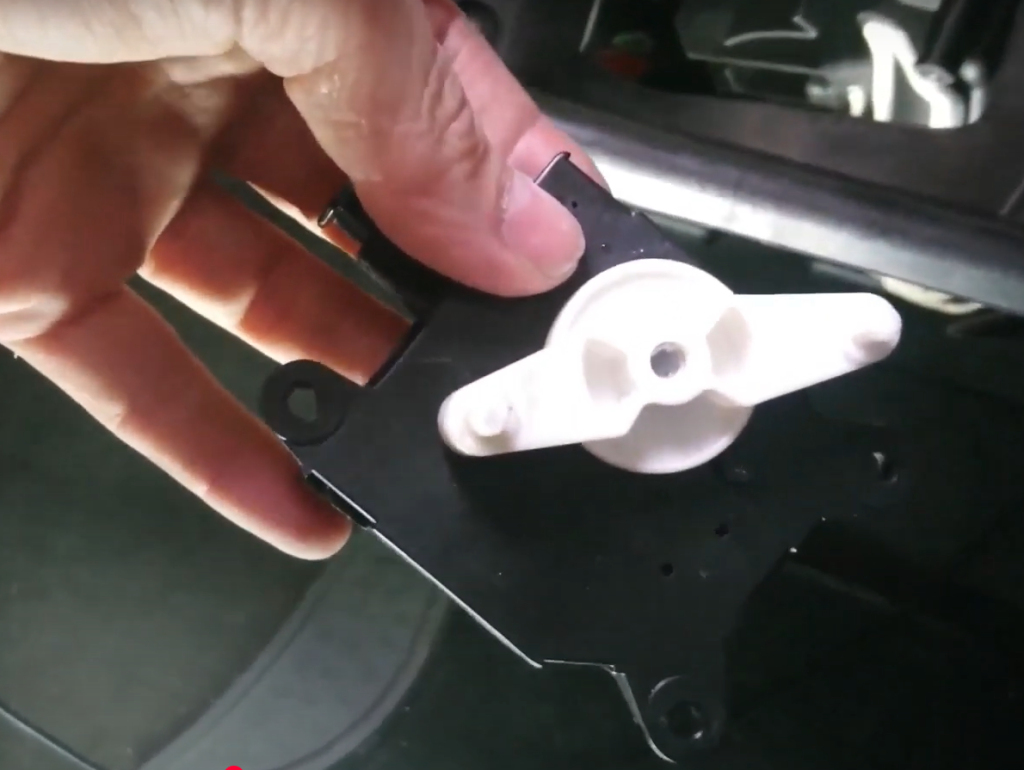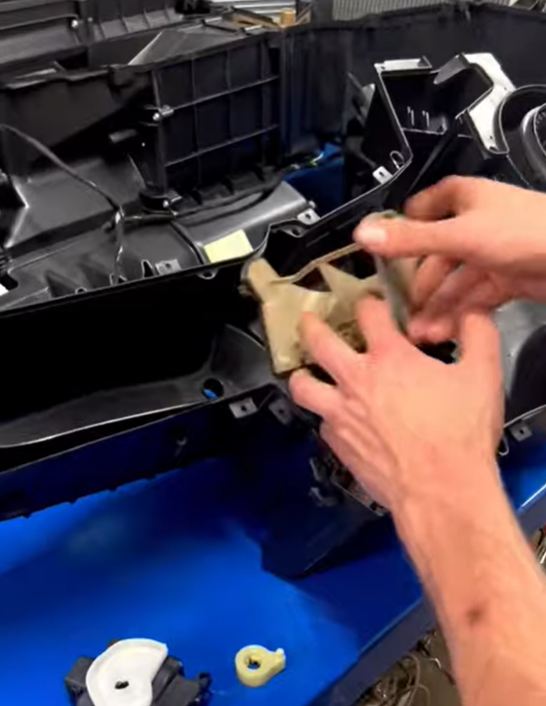A clicking noise behind your glove box can be annoying and concerning. This sound often occurs when you start your car or adjust the temperature controls. The most common cause of this clicking noise is a faulty blend door actuator in your vehicle’s HVAC system.
The blend door actuator is a small motor that controls the flow of air in your car’s ventilation system. When it starts to fail, it can make repetitive clicking sounds as it tries to move the blend door. This issue is not just irritating but can also affect your car’s ability to regulate temperature properly.
Fixing this problem usually involves replacing the faulty actuator. While it’s possible to do this yourself, it often requires removing the glove box and accessing components behind it. If you’re not comfortable with car repairs, it’s best to have a professional mechanic handle the job.
Key Takeaways
- Clicking noises behind the glove box are often caused by a failing blend door actuator
- The issue can affect your car’s temperature control and should be addressed promptly
- Professional help may be needed to replace the faulty component and resolve the problem
Understanding Vehicle Noises
Cars make different sounds that can tell us about problems. Knowing these noises helps fix issues early. Let’s look at common car sounds and parts behind the glove box.
Types of Noises and Their Meanings
Clicking noises in cars often mean something is wrong. A fast clicking when starting may be a weak battery. Slow clicks could be a bad starter motor.
Rattling sounds might be loose parts. Squealing noises often come from worn belts. Grinding usually means brake problems.
Hissing can point to a leak in the cooling system. Knocking sounds in the engine are serious and need quick attention.
Some noises change with speed or when turning. This can help find where the problem is. Paying attention to when and where noises happen is key to fixing them.
Components Behind the Glove Box

Many car parts sit behind the glove box. The blend door actuator is common here. It controls air flow and can make clicking sounds when broken.
The blower motor, which moves air for heat and AC, is also in this area. A bad blower motor can cause strange noises.
Some cars have their cabin air filter behind the glove box. A clogged filter can make the blower motor work harder and create noise.
Wiring for the car’s electrical system often runs behind the glove box. Loose wires can cause clicking or buzzing sounds.
To check these parts, you might need to remove the glove box. This can help find and fix the source of odd noises.
Common Causes of Clicking Noises
Clicking noises behind the glove box often stem from issues with the car’s heating and cooling system. These sounds can be annoying and may point to problems that need fixing.
Air Conditioning Actuators

Damaged electric actuators in the AC system are a frequent source of clicking sounds. These small motors control the airflow and temperature in your car.
When they start to fail, they can make repetitive clicking noises. This happens as the actuator tries to move but can’t complete its motion. The sound often gets louder when you change temperature settings.
Actuators can break due to age, wear and tear, or electrical problems. Fixing this usually means replacing the faulty actuator. It’s best to have a mechanic do this, as they can pinpoint which actuator is causing the issue.
Recirculation Door Fault
The recirculation door in your car’s ventilation system can also cause clicking noises. This door switches between outside air and recirculated cabin air.
If the door gets stuck or its mechanism fails, it may click as it tries to move. This can happen due to debris, a broken gear, or a faulty motor.
The clicking might be constant or only happen when you change air settings. A clogged cabin air filter can make this problem worse. It can let dirt pass to the motor, causing more noise.
To fix this, you might need to clean the area around the recirculation door or replace broken parts. Changing your cabin air filter regularly can help prevent this issue.
Diagnostic Approach
Finding the cause of a clicking noise behind the glove box requires a step-by-step process. This approach helps pinpoint the issue and guides the repair.
Initial Checks
Start by listening carefully to the noise. Is it constant or does it happen only when the car is running? This can help narrow down the problem.
Next, check the air conditioning system. Turn it on and off to see if the noise changes. This can indicate if the blend door actuator is the culprit.
Look for any loose items in the glove box. Sometimes, small objects can cause rattling sounds that seem to come from behind the glove box.
Tools and Techniques
A flashlight is essential for inspecting the area behind the glove box. Use it to look for any visible damage or loose components.
A basic toolkit with screwdrivers and pliers may be needed to remove the glove box for a closer look. This can give better access to the components behind it.
Consider using a stethoscope or long screwdriver to pinpoint the exact location of the noise. Place one end on different parts and the other end to your ear while the car is running.
If the problem seems electrical, a multimeter can help test the blend door actuator or other electrical components for proper function.
Troubleshooting and Repair
A clicking noise behind the glove box often stems from faulty parts in the car’s heating and cooling system. Fixing this issue typically involves replacing broken components or addressing insulation problems.
Replacing Faulty Actuators
The blend door actuator is a common culprit for clicking sounds. To replace it:
- Remove the glove box by unscrewing or unclipping it.
- Locate the actuator behind the glove box area.
- Unplug the electrical connector.
- Remove the mounting screws.
- Install the new actuator.
- Reconnect the wiring and test the system.
This fix usually takes about an hour. It’s important to get the correct replacement part for the specific car model.
Sealing and Insulation Issues
Sometimes, loose parts or worn insulation cause unwanted noises. To address these:
- Inspect the area behind the glove box for any loose components.
- Tighten any loose screws or bolts.
- Check for worn or damaged insulation material.
- Replace or add insulation as needed.
Using foam tape or sound-dampening materials can help reduce vibrations. It’s crucial to ensure all parts are properly secured after making repairs.
Regular maintenance checks can prevent these issues from occurring. If the problem persists, it may be best to consult a professional mechanic.
Preventive Measures
Taking steps to prevent clicking noises behind the glove box can save you time and money. Regular checks and being alert to unusual sounds are key.
Regular Maintenance Tips
Keep your car’s HVAC system in good shape. Clean or replace the air filter every 15,000 to 30,000 miles. This helps the system run smoothly and reduces strain on parts.
Check and tighten any loose screws or bolts in the dashboard area. Vibrations can loosen these over time, leading to rattles or clicks.
Lubricate moving parts like the blend door actuator yearly. A small amount of silicone spray can keep plastic components working quietly.
Inspect wiring connections near the glove box. Loose wires can cause intermittent clicking sounds. Secure any loose connections with electrical tape.
Monitoring Vehicle Sounds
Pay attention to new noises when using climate controls. Early detection of issues can prevent bigger problems later.
Note when clicking sounds occur. Is it only when changing temperature settings? This could point to a specific part needing attention.
Listen for changes in sound intensity. If clicks get louder, it may indicate a worsening problem that needs quick action.
Use a mechanic’s stethoscope to pinpoint noise sources. This tool helps locate exact spots where sounds originate behind the dash.
Keep a log of unusual sounds and when they happen. This information helps mechanics diagnose issues faster and more accurately.
Frequently Asked Questions
Clicking noises behind the glove box can stem from various sources in a vehicle. Understanding the potential causes and troubleshooting steps can help car owners address this issue effectively.
What could cause a clicking noise behind the glove box in my vehicle?
The most common cause is a faulty blend door actuator in the HVAC system. This part controls airflow and temperature in the car’s cabin.
Other possible causes include a loose component, a failing blower motor, or an electrical issue with relays or wiring.
Is it common for a blend door actuator to make a clicking sound?
Yes, it is quite common. The blend door actuator can wear out over time, leading to a clicking or ticking noise when it tries to move.
This noise often becomes more noticeable when the car’s climate control settings are adjusted.
How can I identify the source of a clicking sound in the dashboard area?
To pinpoint the source, one can start by removing the glove box for better access to the area.
Listening closely while operating the climate controls can help locate the exact origin of the sound.
When should I be concerned about a clicking noise coming from behind the glove box?
Concern is warranted if the clicking is persistent or gets louder over time. It may indicate a worsening problem with the HVAC system.
If the noise affects climate control performance or causes discomfort, it’s time to address the issue.
What steps should I take to troubleshoot a clicking noise in the cabin of my car?
First, try to isolate the noise by listening carefully while operating different car functions.
Next, inspect visible components behind the glove box for any loose parts or obvious damage.
Could the clicking noise behind the glove box be related to the vehicle’s HVAC system?
Yes, the clicking is often related to the HVAC system. The blend door actuator is a common culprit.
Other HVAC components like the blower motor or air ducts can also cause clicking sounds if they malfunction.


